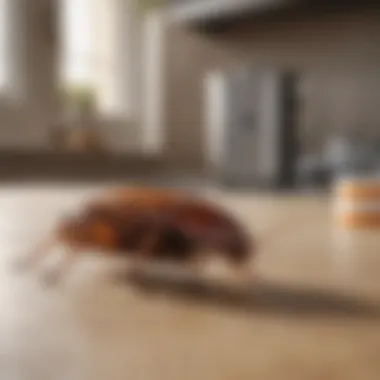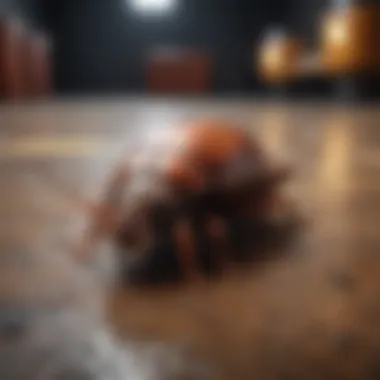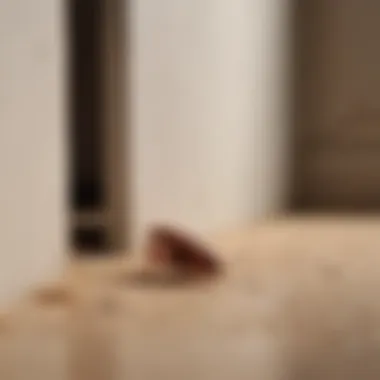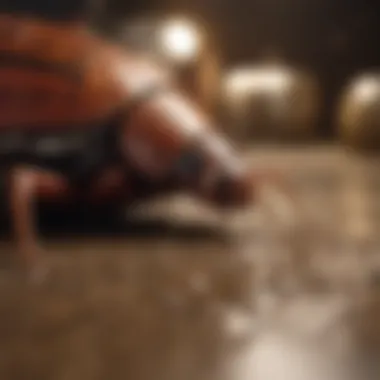Effective Responses to Cockroach Sightings


Intro
Encountering a cockroach can be more than just an unpleasant surprise. It often raises immediate concerns about hygiene, cleanliness, and the potential for pest infestations. This guide is designed to equip you with the necessary knowledge and steps to take should you find yourself face-to-face with a cockroach.
By understanding the biology, behavior, and control methods, you will feel more confident in managing these pests. Whether this encounter occurs in a home, workplace, or outdoor environment, knowing how to respond is crucial.
Animal Overview
Common Name and Scientific Classification
The cockroach is a member of the Blattodea order, which includes several species commonly found in urban and suburban areas. Common species include the German cockroach (Blattella germanica), the American cockroach (Periplaneta americana), and the Oriental cockroach (Blatta orientalis). Each species exhibits distinct characteristics and behaviors.
Physical Characteristics
Cockroaches are easily recognizable by their flat, oval bodies, long antennae, and six legs. Adult cockroaches can range from 1 to 4 inches in length, depending on the species. Their exoskeletons are often brown or black, and they have wings, although not all species fly. The appearance may trigger disgust in many, but understanding their biology leads to better control methods.
Habitat and Distribution
Cockroaches thrive in a variety of environments, often found in warm, humid areas. They tend to inhabit kitchens, basements, and bathrooms, where food and moisture are abundant. Additionally, these pests are adept at finding shelter in cracks and crevices. Globally, each species has its specific distribution, with some preferring urban settings while others are more commonly found in natural habitats.
Behavior and Social Structure
Communication Methods
Cockroaches possess unique communication techniques. They use chemical signals, or pheromones, to relay information about food sources and safe locations. This form of communication plays a significant role in their social interactions and can alert other cockroaches to potential dangers or resources.
Social Hierarchies
While cockroaches are not social insects like ants or bees, they can develop loose social structures. They are opportunistic feeders and often congregate in favorable environments. When food is available, interactions may increase, leading to temporary group formations.
Mating and Reproductive Behavior
Cockroaches reproduce rapidly if environmental conditions are optimal. A female cockroach can produce multiple egg cases, each containing dozens of eggs. Mating typically occurs shortly after the female reaches maturity. Understanding their reproductive patterns can help you better anticipate and address potential infestations.
Health Concerns
Aside from being unsettling, cockroaches pose certain health risks. They can carry allergens that exacerbate asthma symptoms and may contribute to other respiratory issues. Furthermore, they can contaminate food and kitchen surfaces with bacteria, increasing the risk of foodborne illnesses.
Cockroaches can survive on minimal food and water, making them resilient pests that can thrive in various conditions.
Control Methods
To effectively control a cockroach sighting, immediate actions are imperative:
- Do Not Panic: Remain calm. A panicked response can lead to poor decision-making.
- Identify the Type: Recognizing the species helps determine the best control strategy.
- Seal Food Sources: Store food in airtight containers and clean up spills promptly to eliminate attractants.
- Clean Regularly: Maintain a clean living environment to deter cockroaches from returning.
- Consider Pest Control: If the problem persists, consult a pest control professional who can offer tailored solutions.
Preventive Measures
To prevent future encounters with cockroaches, consider the following strategies:
- Inspect Regularly: Routinely check for signs of cockroach activity in your home or workspace.
- Eliminate Hiding Spots: Seal cracks and crevices where cockroaches can hide or enter.
- Manage Moisture: Repair leaks and remove any standing water to reduce humidity levels.
Being informed about cockroaches and their behaviors allows for effective management. Knowing what to do in case of an encounter can lead to a cleaner and healthier environment.
Understanding Cockroaches
Understanding cockroaches is a fundamental aspect of managing any encounters with these pests. Awareness of their behavior, habitat, and life cycles enables individuals to respond effectively when faced with a sighting. By grasping what cockroaches are and their characteristics, readers can better assess situations and take appropriate action. This knowledge helps in identifying potential infestations and, consequently, applying suitable control measures.


Common Species
There are several common species of cockroaches that inhabit various environments. The most prevalent ones include the American cockroach, German cockroach, and Oriental cockroach. Each species has distinct traits:
- American cockroach: Often found in warm locations, this species can grow to be quite large, about 2 to 4 inches long. They thrive in damp areas such as basements and sewers.
- German cockroach: Smaller in size at around 1.1 to 1.6 inches, this species is notorious for its rapid reproduction. It often inhabits kitchens and bathrooms, preferring warm, humid spaces.
- Oriental cockroach: With a length of about 1 to 1.3 inches, the Oriental cockroach is usually found in cooler, damp areas like basements and drains. It is distinguishable by its dark color, appearing black or dark brown.
Recognizing the species of cockroach you encounter can facilitate better approaches to management. Each species may require tailored methods of control, affecting the strategies you choose to implement.
Life Cycle and Behavior
Cockroach behavior and life cycles are critical for understanding how to confront them. Typically, cockroaches undergo three stages: egg, nymph, and adult. The egg stage can produce hundreds of offspring in a lifetime, giving rise to potential infestation.
- Eggs: Female cockroaches lay eggs in protective cases known as oothecae. Each case can contain numerous eggs, depending on the species.
- Nymphs: When the eggs hatch, nymphs emerge. These young cockroaches resemble adults but are smaller and lack fully developed wings. They require several molts before reaching maturity.
- Adults: Adults are capable of reproduction and play a significant role in an infestation. They require food, moisture, and shelter to thrive, continuing the cycle of life.
Cockroaches are primarily nocturnal, making them more active at night. This behavior often catches individuals off guard, leading to startled reactions upon sightings. They tend to hide in dark, tight spaces during the day, contributing to a stealthy approach that can complicate detection.
In summary, understanding cockroaches involves recognizing their species, life cycle, and behavior. This knowledge is not only vital for immediate response strategies but also plays an important role in long-term pest management efforts.
Immediate Actions Upon Sightings
Encountering a cockroach can evoke a strong reaction. However, how one responds immediately can greatly influence the overall outcome. The importance of immediate actions cannot be overstated. It involves both assessing the situation and making decisions that can lead to effective management of the problem. Undertaking appropriate steps right after the sighting sets the groundwork for a more strategic approach to dealing with potential infestations.
Calmly Assess the Situation
When a cockroach is spotted, the first instinct may be to react impulsively. However, taking a moment to calmly assess the situation is key. This involves observing where the cockroach is located, its size, and its movements. Noting if it is alone or if multiple cockroaches are present can inform your next steps.
Understanding the area where the cockroach was seen is equally important. Is it a clean kitchen environment, a cluttered living room, or an outdoor space? Recognizing this context will help in determining potential food sources and hiding spots that may attract more cockroaches. Moreover, if it appears to have fled, trying to remember its path can be beneficial in identifying possible entry points to your home. This assessment will provide clarity and should guide any subsequent actions.
Avoid Panic
If children or pets are present, alleviate their fears without dismissing their concerns. It can be helpful to explain the situation simply. Share that while a cockroach sighting can appear alarming, many species are not harmful, and there are effective ways to manage them. By avoiding panic, you maintain a clear head, enabling you to formulate and implement a practical response strategy.
Effective initial responses to a cockroach sighting can significantly reduce the risk of a larger infestation.
In summary, how one reacts immediately upon seeing a cockroach plays a crucial role in the overarching strategy for pest management. A composed assessment of the situation alongside a commitment to avoiding panic can ultimately guide more thoughtful decisions regarding pest control and preventive measures.
Health Risks Associated with Cockroaches
The health risks linked to cockroaches extend beyond mere discomfort. These pests can contribute to serious health concerns, particularly for certain vulnerable populations. Understanding the implications is essential to maintaining a safe and sanitary environment. Cockroaches are carriers of allergens and may pose various diseases. Recognizing the potential hazards is a key element in addressing an infestation effectively.
Allergens and Asthma Triggers
There is a significant link between cockroach presence and allergic reactions. The feces, saliva, and body parts of cockroaches contain potent allergens. When these allergens become airborne, they can trigger respiratory issues. This is notably concerning for individuals with asthma or other pre-existing respiratory conditions. Research indicates that exposure to cockroach allergens can aggravate asthma symptoms. Individuals living in households with cockroach infestations may be at a heightened risk for severe asthma attacks.
Preventing these allergens from entering the home requires diligence. Regular cleaning is vital to minimize potential exposure. Vacuuming carpets, wiping shelves, and sanitizing common areas can help. Moreover, sealing any cracks or crevices where cockroaches might enter is crucial. For those with asthma, it is wise to monitor symptoms closely and consult healthcare professionals for guidance.
Potential Disease Transmission
Cockroaches are not just a nuisance; they can also be vectors for disease. They can spread pathogens through their contaminated bodies and excrement. Various studies have shown that cockroaches can carry bacteria such as Salmonella and E. coli. Exposure to these pathogens can lead to gastrointestinal diseases, which may manifest as symptoms like diarrhea and vomiting.
Beyond bacteria, some research links cockroach exposure to other serious illnesses. For example, children may experience more severe respiratory conditions after prolonged exposure. In addition, some infectious diseases may not be immediately apparent but can have long-term health effects.
When thinking about pest control, it is vital to consider these health risks. One approach is to maintain an integrated pest management plan, which focuses on prevention as much as eradication. This method involves understanding the environment, assessing risks, and taking proactive measures against cockroach populations.
"Effective pest control is not just about immediate results; it is about understanding long-term health implications."
In summary, being aware of the health risks associated with cockroaches allows for informed decision-making regarding pest control strategies. Taking action early can help improve the overall quality of life in affected environments.


Effective Control Methods
Controlling cockroach populations is crucial for maintaining a hygienic environment. Effective control methods reduce the threat these pests pose to health and quality of life. Implementing suitable strategies can mitigate the risk of infestation and enhance peace of mind in any space. Understanding various control options is important as it provides both immediate relief and long-term solutions.
Traps and Baits
Traps and baits are common strategies for managing cockroach issues. These devices function by attracting cockroaches with enticing substances. Once lured, they either get trapped or consume poison.
- Sticky traps: These are useful for monitoring cockroach activity. Place them in areas where you suspect infestation. This provides insight into the severity of the problem.
- Bait stations: These attract cockroaches and contain poison. Cockroaches consume the bait and return to their hiding spots, effectively allowing for population control.
It is essential to position traps and baits strategically. High-traffic areas, such as kitchens and bathrooms, are ideal locations. Regular check-ups are also necessary to ensure effectiveness.
Insecticides and Sprays
Insecticides come in various forms, including sprays, powders, and gels. These chemicals are designed to kill insects upon contact or ingestion. There are considerations when using insecticides, such as safety, effectiveness, and environmental impact.
- Sprays: These offer quick results and can be applied directly to areas where cockroaches are seen. However, they may require reapplication as they can lose effectiveness over time.
- Boric acid: This is a well-known insecticide for cockroaches. It disrupts their digestive systems when ingested, eventually leading to death.
When using insecticides, follow instructions carefully. Ensure proper ventilation and protect non-target areas to avoid unintended consequences.
Professional Pest Control Services
When infestations become severe or persistent, enlisting professional pest control services is advisable. Experts have access to specialized tools and treatments that may surpass DIY options. They evaluate the situation comprehensively, identifying underlying issues that contribute to infestations.
Working with professionals comes with several benefits:
- Expertise: Pest control technicians possess extensive knowledge about cockroach behavior and the most effective treatments.
- Long-term solutions: Professionals not only address the current problem but can also suggest ongoing strategies to prevent future infestations.
- Safety: They utilize methods that are safe for humans and pets, ensuring minimal disruption to daily life.
Preventive Measures to Avoid Infestations
Preventive measures are essential for effective cockroach control. Understanding how to deter these pests can significantly reduce the likelihood of an infestation. Action taken before a sighting is crucial because once cockroaches establish a presence, eradicating them can become much more complicated and costly. Applying preventive strategies not only protects your immediate environment but also contributes to overall hygiene.
Maintaining Cleanliness
One of the primary steps in preventing cockroach infestations is maintaining cleanliness in your living or working space. Regular cleaning routines are vital. Focus on areas that attract moisture and food.
- Kitchen: Keep countertops, stoves, and the floor free of crumbs and spills.
- Dining Areas: Clean tables and remove uneaten food promptly.
- Trash Management: Use sealed trash bins and dispose of garbage regularly.
Additionally, check for hidden food sources. Cockroaches can thrive in overlooked spots like under appliances and in food packaging. Cleaning these areas should be part of your routine.
Sealing Entry Points
Sealing entry points is another critical preventative step. Cockroaches can enter through surprisingly small openings. Inspect your home or building for vulnerable areas:
- Cracks and Gaps: Fill in gaps around windows, doors, and pipes with caulk or weather stripping.
- Ventilation Screens: Ensure all ventilation outlets have intact screens.
- Foundation: Inspect for cracks in the foundation and seal them if necessary.
Addressing these entry points can significantly lower the risk of cockroach entry and subsequent infestations.
Regular Maintenance and Inspections
Conducting regular maintenance and inspections in your home can also help prevent cockroach troubles. This includes:
- Routine Inspections: Check basements, attics, and storage areas regularly. Early detection of signs of cockroaches—like droppings or shed skins—can help address problems before they escalate.
- Professional Services: Consider hiring pest control professionals for periodic inspections and maintenance. Their expertise can uncover potential issues you might miss.
- Environmental Control: Maintain a dry environment since cockroaches are attracted to moisture. Fixing leaking pipes and ensuring good drainage systems can be a long-term solution.
Consistent preventive measures are your best defense against cockroach infestations.
By implementing these preventive strategies and staying vigilant, you can create an environment that is unwelcoming to cockroaches, securing your space from unwanted pests.


What to Avoid
When faced with a cockroach sighting, it’s critical to understand the aspects to sidestep to ensure effective management of the situation. Ignoring key problems or relying on ineffective solutions can lead to greater infestations and health risks. This section will outline the two primary categories of avoidance: subpar DIY solutions and neglect of the issue altogether.
DIY Solutions with Limited Effectiveness
Many people tend to lean towards do-it-yourself methods when confronted with pest problems. While some DIY solutions might seem appealing due to their simplicity or low cost, they often yield minimal results regarding cockroaches. Common options include homemade traps or natural repellents. However, these methods rarely address the root cause of an infestation.
Consider the following points when evaluating DIY solutions:
- Limited Reach: Many DIY methods can only target the roaches they can physically interact with, and might not eliminate the entire population hiding within walls or under appliances.
- Temporary Fixes: These approaches may offer a short-term solution but will not stave off future infestations without a more comprehensive strategy.
- Neglecting Professional Advice: Attempting to tackle the problem without consulting pest control experts can lead to wasted time and resources. Consulting a pest management professional often yields better results and a clearer understanding of the infestation.
Relying on ineffective DIY methods often results in a temporary illusion of control without ridding your space of the problem.
Ignoring the Problem
Choosing to ignore the presence of cockroaches is arguably one of the most detrimental actions one can take. Many individuals may feel overwhelmed or unsuccessful in dealing with the pest, leading to apathy and avoidance. However, this can create larger issues down the line.
Here are some implications of ignoring the issue:
- Increased Population: Cockroaches reproduce rapidly. Over time, a few sightings can quickly escalate into a more significant infestation. This means a more complex and expensive solution will be required later.
- Health Risks: As noted previously, cockroaches can carry allergens and disease pathogens. Failing to address the presence of these pests can increase health risks for you and your family.
- Property Damage: Cockroaches may cause damage to property, especially if they infest areas where food is stored or prepared. This can lead to costly repairs or replacement.
In summary, avoiding ineffective DIY solutions and the urge to ignore cockroach sightings is vital. Proactive measures and proper identification of effective approaches will lead to better pest management overall.
Anticipating Future Encounters
Anticipating future encounters with cockroaches allows individuals to take proactive measures. Knowing when and why these pests may appear can significantly influence prevention strategies. This foresight aids in maintaining a hygienic environment and reducing anxiety surrounding their presence.
Seasonal Patterns of Cockroach Activity
Cockroaches are not active year-round in the same way. Their behavior often correlates with seasonal changes. In warmer months, such as late spring and summer, cockroach activity tends to increase. Favorable temperatures and humidity create ideal conditions for their growth and reproduction.
During autumn and winter, many species seek shelter in homes, driven by the desire for warmth and food. Understanding these seasonal patterns means you can increase vigilance during specific times of the year. For instance, it may be wise to conduct more frequent inspections or increase cleanliness efforts when warmer weather approaches. If homeowners recognize these patterns, they can act before infestations become severe.
Understanding Environmental Factors
Environmental factors significantly influence cockroach activity and behavior. These factors include humidity, temperature, food availability, and hiding places. High humidity tends to attract roaches, as they thrive in moist conditions. Ensuring that homes and buildings are well ventilated and dry can deter them.
Temperature also plays a critical role. Cockroaches prefer warmer climates, so keeping living spaces at moderate temperatures can lessen the likelihood of infestations. Additionally, maintaining cleanliness by eliminating food sources — such as crumbs, spills, and pet food — can minimize attraction.
Finally, understanding potential hiding places is crucial. Cockroaches often take refuge in dark, confined spaces like cracks, crevices, and behind appliances. They search for environments that provide security and access to food. Identifying and reducing these spaces in a home can effectively deter cockroach presence.
Being aware of the environmental factors that attract cockroaches is essential for successful long-term prevention.
Closure
Understanding how to respond upon seeing a cockroach is paramount for maintaining hygiene and preventing infestations. This article tackles the challenges and responses related to cockroach encounters. Recognizing the proper steps to take ensures not only effective management of these pests but also highlights the health implications associated with them.
Summary of Effective Response
When a cockroach is sighted, the initial response matters. For effective practices, consider the following:
- Remain Calm: This helps maintain a clear mind for decision-making.
- Assess the Situation: Determine if single roaches indicate a larger infestation.
- Immediate Control Measures: Utilize traps or baits promptly.
Understanding these steps fosters a proactive approach and reduces possible tensions related to unexpected encounters.
Importance of Ongoing Vigilance
Vigilance is key in managing cockroach problems. Regular inspections and preventive actions are beneficial:
- Routine Cleaning: Regularly cleaning your home can limit food sources for cockroaches.
- Sealing Entry Points: Close gaps around doors and windows to make it harder for pests to enter.
- Monitoring Signs of Infestation: Be observant for droppings or egg casings, indicating a potential problem.
By remaining vigilant, one can ensure that cockroach infestations are not just managed but also prevented.
Regular monitoring and actions taken as outlined are crucial for keeping cockroaches at bay and maintaining a healthy living environment.







